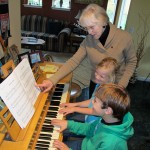Sharing … involvement … community building … these are just some of the concepts that come to mind when describing a cooperative enterprise. Cooperative living arrangements and cooperative schooling are two ways that families come together in the North State to share, get involved and grow in their communities with other like-minded individuals. With a greater involvement from members, there is an added economic benefit, making this an attractive alternative to traditional housing or schooling.
Two Well-Established Cooperative Schools
Two well-established co-operative pre-schools in the North State are Redding Cooperative Preschool, founded in 1956 in Shasta County, and Chico Nursery School in Butte County, which was started in 1968. One of the main philosophies of cooperative schooling is that parents are considered the primary educators of their children. “You become your child’s teacher,” states Jula Herzog, director of the Redding preschool. When her children were attending the school, Herzog became so inspired by it that she returned to college to become a teacher. “I fell in love with the co-op and completed my degree in Early Childhood Education,” she explains. She has served as the teacher/director for the past five years.
Strong parental involvement in cooperative schools means there is a high adult-to-student ratio, and keeps staffing expenses low. At Chico Nursery School the adult to child ratio is 1:5; at Redding Cooperative Preschool it is 1:4. The Board of Directors and classroom assistants are all parents … the director/teacher serves as the only paid employee at each school. The schools both conduct monthly meetings to discuss curricula and to further educate the parents. At the Redding preschool guest speakers are brought in to talk to the parents about different aspects of child development.

Chico Nursery School teacher Jessi Wood, and parent helpers April Seegrist and Jenny McHenry, enjoy dance-active play time with young students.
Being part of a school co-op does require contributing a significant amount of time and labor. Parents are usually required to work in the classroom one day a week; grandparents or other caregivers can substitute in the classroom for a working parent, or parents can find other parents to trade with them. At Chico Nursery School, a “sibling room” was created for families with younger children so that parents have a place for their younger children during their shift at the school. Director Jessi Wood says, “One of the goals is to try to make Chico Nursery School accessible to working families and to families with younger toddlers and babies.”
Parental involvement keeps tuition costs down, which, according to Wood, is about one-third the cost of a traditional preschool. Fundraising and serving on committees are also required commitments. At the Redding preschool, fundraising activities include an annual children’s concert with Shasta High School’s band, and a very popular yard sale held every March. Chico Nursery School hosts an annual rummage sale each April.
Both schools are well-established preschools in their respective communities. Wood loves meeting former students who enjoy sharing their fond memories of learning and playing at the school. “Together, we’re better!” exclaims Wood.
Valley Oaks Village – The North State’s Only Housing Co-operative

Valley Oaks Village community members. Photo: Michele Miller, photo manipulation by Titus Willoughby Woods.
Sitting on approximately five acres near Bidwell Park in Chico, Valley Oaks Village is a cohousing neighborhood founded in 1996. According to the Cohousing Association of the United States, “Cohousing is a type of collaborative housing in which residents actively participate in the design and operation of their own neighborhoods.” Individual homes are privately owned and maintained, and there are common areas shared and managed by all residents.
One of the original developers of Valley Oaks Village was Penny Paulus, who currently serves as the primary contact for the Valley Oaks membership team. Paulus states that the co-operative founding members got lucky finding such a nice location. “Our group had been meeting and planning for six years before we finally found land that would work for us,” says Paulus, “A lot of thought was put into the design of energy efficient, passive-solar homes.”
To invite a sense of community, the twenty-eight homes are attached in different configurations around a large oval open space. Each building unit consists of two or three homes joined together. The village’s central “Common House,” lawn and pool are all linked by pathways and a dry creek bed, which meander through a park-like setting of oaks and sycamores. There are also communal gardens and an orchard with a wide variety of fruit trees. The proximity of Bidwell Park and its bike paths allows many residents to bicycle to and from work and school.
Paulus, husband Jay Goldberg and son Tashi are one of seven families who are founding members of Valley Oaks. Their building was the first completed, in April 1996. Paulus notes that after they moved in it was fun watching the other buildings go up. Paulus’s son was only five years old, and “there was great excitement as each new family moved in.” Valley Oaks is a neighborhood with people of diverse ages and backgrounds, and children are viewed as a vibrant component; “growing” families into the co-operative community continues to be a priority (Contact Valley Oaks about current units for sale.)
“Kids are a big part of life in our community,” says Paulus. Currently there are 60 adults and 19 children living at Valley Oaks Village. Special events and holiday celebrations are planned throughout the year, such as an Easter brunch and egg hunt, a community Thanksgiving gathering, a “school’s out” barbecue, and family trips to Yosemite and Mt. Shasta. Children have many places to socialize, including a recreation room, rumpus room, swimming pool and even a band room for a newly formed teenage band. The children enjoy heading to “The Grass” to play around the outdoor play structures, as well as “chalking up” the paths along the dry creek bed.
Valley Oaks Village is governed by a homeowners’ association, and decisions are made by consensus, with no designated leader. Residents contribute eight hours of labor each month to support the many aspects of the community and to reduce their homeowners’ fee. Tasks vary, and include cooking meals, landscape maintenance, cleaning the Common House, and organizing community activities. The preparation of evening meals at the Common House about twice a week for community members is a benefit for those members who want to eat together, especially for those who are working parents, as it frees them from planning and preparing meals. Members pay money in advance into a meal fund and then are charged $3.50/per meal. Paulus recalls, “As a working mom it was always a welcome relief to come home from work and have time to spend with my son, and not have to worry about preparing dinner.”
Cooperation means working or acting together toward a common end or purpose. These cooperative arrangements, with their shared goals, benefits and responsibilities, have fostered unique communities that certainly benefit families and children. As Herzog emphatically states, “I love my co-op!”
Valley Oaks Village
1950 Wild Oak Ln., Chico
(530) 893-9379
http://www.chicocohousing.com
Chico Nursery School
1190 East 1st Ave., Chico
(530) 891-1723
http://www.chiconurseryschool.org
Redding Cooperative Preschool
658 Mary St., Redding
(530) 241-4355
http://www.reddingcooppreschool.org
Comment Policy: All viewpoints are welcome, but comments should remain relevant. Personal attacks, profanity, and aggressive behavior are not allowed. No spam, advertising, or promoting of products/services. Please, only use your real name and limit the amount of links submitted in your comment.
You Might Also Like...

Meeting the Moment: Trauma and Resilience Training for Educators
Michelle, a dedicated teacher in San Diego, describes the persistent challenges posed by Lana, one of her students. Lana consistently refuses to follow instructions, disrupts the class with her loud […]

Great Ways Dads are Different
There is no denying that there are differences between how moms and dads parent their kids. Just because dads may do things differently than moms doesn’t mean their parenting style […]

Growing Up Fit – Family Fitness, Age by Age
Growing Up Fit Family Fitness, Age by Age Childhood may seem to move at a faster pace these days, but children don’t. New research from the American Heart Association shows […]

North State Parent 2015 Music Essay Contest Winner: Sean Bostrom
Sean Bostrom, age 16, started playing piano at age 8, and more recently started playing violin. He currently studies piano with Dustin Breshears, and violin with Carla Shryock at the […]










